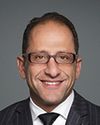Let me take the second half of that first. You can mute words and accounts on Twitter, so if you were interested in the Raptors game tonight and couldn't see it, you could mute #WeTheNorth, #TorontoRaptors. You can filter that out of your conversations currently if you wanted to, in case you missed the game.
We are working on that, but right now, if you look on your account, you'll see “mute words” or “mute accounts”. You can do that to help filter through what you are and are not seeing. It's the same with the sensitive media setting.
With regard to information integrity and with regard to trusting who you're interacting with, this is actually something I testified on at the Senate last year. It is something that we are studying very carefully. Our verification process is on hold because we were unhappy with how it was being applied. We couldn't find a consistent policy that would reflect well to our users what it was about. It's something we are working on.
We're also making product changes daily. We have something now called the profile peak. As you're scrolling through, you can just hover over the image of the person you're interacting with and their profile will pop up. Further, we now also tell you where they're tweeting from and when so that you can understand if they're tweeting from their iPhone, if they're tweeting from Hootsuite or some other sort of third party application.
I take your question and your comment seriously. It is something that we are working on to improve the user experience.




